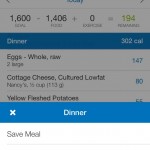 Nutrition – a.k.a. eating – has proven to be the most overwhelming part of my clients’ fitness journeys. This is the shortest breakdown I could craft of the three steps I help them through (and why), the most common pitfalls along the way, and what the journey usually looks like.
Nutrition – a.k.a. eating – has proven to be the most overwhelming part of my clients’ fitness journeys. This is the shortest breakdown I could craft of the three steps I help them through (and why), the most common pitfalls along the way, and what the journey usually looks like.
To reply to common objections before we even begin:
- Yes, you could do all three steps at once, but most people find that too overwhelming. The sooner you successfully and authentically get through steps one and two, the sooner you will see the scale move. (Nutrition is not all about the scale moving! But that’s how the topic usually comes up.)
- Yes, this works, and it works pretty well even if you only make it through step 1 successfully – unless you have an underlying health condition that interferes with your digestion and/or absorption, or your lifestyle factors (like sleep and stress) are out of control. (If the latter is the case, get your health, stress, and sleep under control before you try to make big changes to your body composition – your health matters!)
- As a personal trainer, it would be easy to put you on a “meal plan” of plain chicken and asparagus, but nutrition isn’t punishment and that’s just not realistic, necessary, sustainable lifelong, or ideal for most people.
- Cynicism is fear in disguise. It’s cool if you’re afraid to make changes, but recognize that and, one day, face it!
1. Step One: Eat the right amount
Weight loss and maintenance both is and is not as simple as energy in vs. energy out. You will likely not succeed at losing weight by creating an energy deficit (the difference between energy out and energy in) just by eating less or just by working out – your body is complex and there are multiple hormones involved in weight regulation, and so we need both movement and the right amount of food to get things headed in the desired direction.
This step usually takes my clients 6-9 months to absorb, because most people are afraid to eat enough or afraid that the idea of “eating enough” will turn into license to eat everything in sight, especially if they’ve been undereating or “dieting” for a long time. The thing is, if you’ve been restricting your calories for at least two of months and not losing any weight, you have your own proof that undereating doesn’t work for weight loss. You need to eat enough. This is the short version of this info, but I promise that will come back to information behind that point in a future blog!
I calculate all of these numbers for my clients, but if you’re a healthy adult (and not pregnant or dealing with any digestive issues or other chronic conditions) you can find your rough numbers yourself by:
- plugging your accurate data (what the scale *really* says) into this BMR calculator
- multiplying that number by 1.2 to find the rough amount of calories you burn being alive in a day
- multiplying that number by 7 to find your total weekly caloric outlay from being alive
- adding up the amount of calories you will actually burn in a week by working out (no need to over- or under-estimate here – find a reliable tool to give you an estimate of what you will burn, or ask your fitness professional) – this depends on your current weight, fitness level, and exertion level during your activity, so make sure you’re using an accurate tool and only taking into account deliberate fitness activities that elevate your heart rate and get you moving, not lifestyle activities like doing your job or walking the dog
- adding your workout calories burned to your total weekly caloric outlay from being alive
- subtracting 2500 from that number if you’re within 20 pounds of a “healthy” weight for your height, 3500 from that number if you’re within 30 pounds of that same weight range, and consulting a health for fitness professional for a safe nutritional range if you’re over 30 pounds away from your goal.
- dividing the resulting number by 7 to find how many calories you should eat in a day. If this number comes out below 1250, go back to step 4 and find time to add another workout to your week, then recalculate.
…and that was the short version. If it was as simple as “skip dinner”, I would tell you.
2. Step Two: Eat the right balance
Once you’re eating enough, it’s time to get your macronutrients (protein, fat, and carbohydrates) in balance – and make sure you’re eating moderate portions regularly throughout the day. Both of these changes will help keep your blood sugar happy, which will dissuade your body from storing more fat and encourage it to release any extra stored fat.
There’s no universal macronutrient ratio – needs vary by gender, activity level and type, age, stress and sleep levels, other hormonal issues, dieting history, and other individualized physiological aspects. However, a good place to start – while remaining ready and willing to observe your results and make changes every two weeks – is with 50% carbohydrates, 30% protein, and 20% fat. (My clients get their own ratios when they’re ready, and a professional can help you find yours, too.)
This step usually comes together pretty quickly for my clients – most have found a pretty good balance after just 4-6 weeks of easy food swaps and upgrades. The most common issue that my clients face is having to reclassify foods they thought of as protein into their proper categories at fats or carbs, which takes a little bit of attention to food tracking and/or label reading. Once this step is in line, the scale really starts to take off in motion.
3. Step Three: Make the best choices
This step takes somewhere between two months and the rest of your life, and it’s the time to start considering each of your individual food choices and what they contribute to your health. Is toast the best choice at breakfast (while comforting and familiar, it might not give you many nutrients), or would a sweet potato (with its vitamin A and fiber) be a good upgrade? Deli meat has been providing your protein at lunch for step 2’s balancing act, but would a home-cooked meat that doesn’t contain preservatives be better for you?
The “best” choice isn’t always a salad or to skip the cake – figuring out this step will require you to stay in touch with your priorities. Life is a long journey with many seasons, and so this step is an invitation to reflect on your choices over the course of a day or week and make sure your body is getting some nutrition out of your food so that you have the energy and clarity you want for your day. Goals like getting 5 servings of fruits and veggies a day, making sure you get your necessary calcium, iron, and magnesium, and keeping an eye on the amount of added sugar you consume in a day are all part of this step.
This step is not only important for your health, but it helps determine the quality and stability of your results. If you get your daily carbs from Ben & Jerry’s, you might be disappointed in some aspects of your progress. On the other hand, if you skip the cake at every future birthday and wedding, you will definitely be disappointed.
Overthinking can make this step way too hard, so take your time, eat day by day and week by week, and let your food choices evolve naturally, seasonally, and flexibly.
Eat enough, eat the right balance of nutrients, and make the best choices for you. Seems simple, usually takes about a year to implement – but the changes last a lifetime. You likely eat 1,456 meals and snacks every year, so give your nutrition some attention and put it to work for you and your goals!


